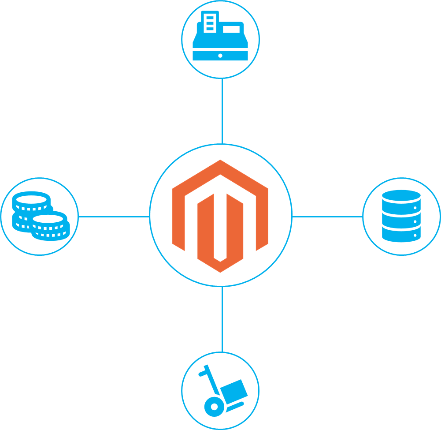Are you growing more and more frustrated with running your multichannel business? All growing merchants face their breaking point. You can’t keep up with customer demand. You continue to frustrate customers with a poor experience and start losing them.
You know there’s a better way out there to run your business, but how do you know you’re ready to take the next step?
Here are our top 10 signs that you’re ready to integrate your Magento webstore with your other backend systems like an ERP, accounting, POS, or logistics systems so you can start automating your business processes.
10 Signs that You Need Multichannel Magento Integration
Without integration for their Magento storefront, merchants tend to experience the same types of problems or growing pains. When you sell across multiple channels (both online and offline) and your systems aren’t connected, it can lead to problems like these.
Which of these problems do you experience daily?
1. You keep overselling.
When you sell across multiple sales channels, inventory quantities are constantly changing, to the point where you can’t keep up. Some sellers might take one day a week to update all their systems with the correct quantities. This puts you at risk for overselling and there’s nothing worse than having to tell customers that you can’t ship an item that they bought or products constantly being on backorder.
2. Your staff members are dedicated to manual data entry.
Before integrating, almost all the merchants we work with have full-time staff members who spend all their time doing nothing but grabbing orders from Magento and re-entering them into their ERP or POS for order processing. Some merchants report spending 40+ hours a month on just manual data entry. Not only is this a waste of your employee’s talents, but it’s an expensive and unproductive way to process orders.
3. You continue to ship orders late or wrong.
On top of wasting time, manually entering data between Magento and your other system puts you at risk for inconsistent and erroneous data that leads to orders being shipped wrong. Also, hand-keying data takes a lot of time. We’ve had merchants report that manual data entry was causing 24+ hour delays in order processing. You can’t deliver packages when you promised.
How many resources do you spend on responding to customer inquiries and correcting your team’s own errors?
4. Your online and offline experiences aren’t connected.
You know customers shop across multiple channels both online and offline. For items they want to buy in-store, they often start their search online. When they arrive on your site, they want to be able to check inventory levels by each of your location before heading into the store to complete their purchase.
Are you able to provide this information for your customers? Without integrated systems, merchants can’t provide this data that enables multiple fulfillment options like buy online, pick-up in-store.
5. Your current processes are prohibiting your growth.
As mentioned above, all growing merchants meet their breaking point. Customer demand outpaces your ability to keep up with orders and inventory. While you want to grow, your current processes are holding you back. Most of the new customers you bring in just end up being frustrated customers that don’t shop with you again. You’re so caught up trying to maintain your current capacity that you can’t focus on improving your business.
6. Your customer experience is suffering.
Merchants with inefficient or broken processes tend to spend more time fixing errors for customers, instead of finding new ways to enhance their customer experience. Spending more time on answering customer complaints than improving your checkout process or enriching product information is frustrating for both your customers and employee. Your customers will find somewhere else to spend their money.
7. Your apps aren’t solving your problems.
Many merchants rely on eCommerce apps and add-ons to add custom functionality to their online stores. However, merchants can outgrow these apps overtime or create a mess of processes trying to get multiple, custom apps to work together. You might realize that your apps are causing more problem than they’re solving.
8. Your product information is a mess.
All merchants wrestle with keeping updated and rich product information. It’s even harder to keep product data straight across multiple channels. Just like inventory quantities, product information becomes a tedious and time-consuming task when relying on manually entering it across your systems. You might notice that product data is often wrong or incomplete for your listings, which could be turning potential customers off when they’re shopping with you.
9. You can’t make the right decisions for your customers when you need to.
Without timely and accurate data, you can’t make the right decisions for your customers when you need to. For example, at any given time, do you know how much of a product you sold and how many you have of each one currently?
If you don’t trust your data, then your team isn’t equipped to make critical decisions like when to move inventory from one store to another, when to mark down products, or how to market in one region versus another.
10. You can’t compete online.
When you add all these problems up together, your company isn’t in a position to sell competitively online. You don’t have the right data when you need it. You can’t process your information to make impactful changes for your business, and ultimately, your customer experience. You feel that while you’re busying just trying to keep up with normal demand, your competitors are passing you by.
Benefits of Magento Integration
 The best way to overcome growing pains like these is to connect Magento with your backend systems like your ERP, POS, 3PL, or Accounting software (wherever you fulfill orders out of). Integration allows you to centralize how you manage inventory, orders, customers, items, and shipping/tracking data.
The best way to overcome growing pains like these is to connect Magento with your backend systems like your ERP, POS, 3PL, or Accounting software (wherever you fulfill orders out of). Integration allows you to centralize how you manage inventory, orders, customers, items, and shipping/tracking data.
You can automate processes like order fulfillment, inventory updates, and product listings, while eliminating the need for manual data entry. You’ll cut down order processing from hours to minutes. Team members can focus on enhancing the customer experience, instead of just data entry. You’ll generate reports in minutes so you know your inventory quantities at any given time. You can ship same-day and guarantee your delivery dates. You’ll also be able to add more advanced capabilities like buy online, pick-up in-store to improve your customer experience and compete better.
If you’re ready to see how multichannel integration can help your business, check out nChannel’s pre-built integration practice for Magento to see if it’s the right fit for you.






Join The Conversation